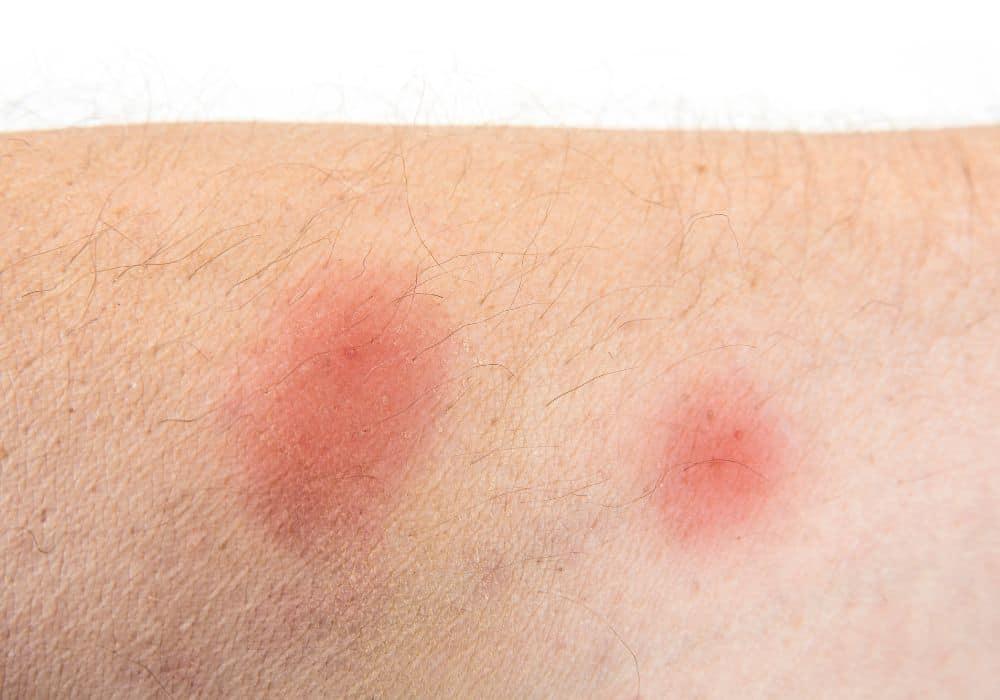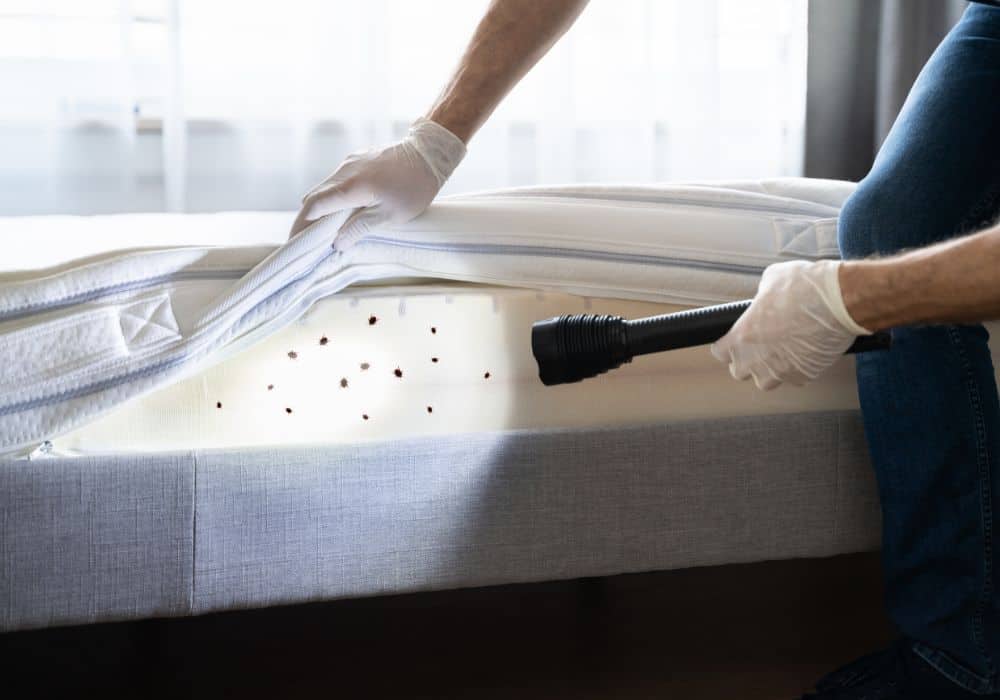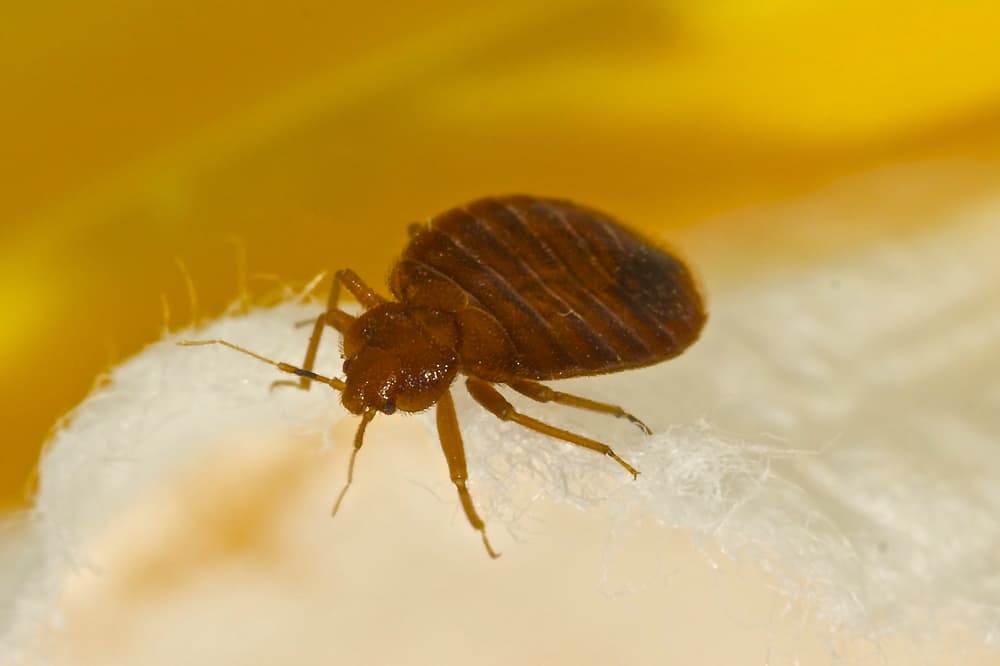Of all the biting and stinging insects and pests out there, bed bugs aren’t the most dangerous ones but they are certainly some of the most annoying and disturbing. The idea of countless little mites crawling in your bed frames, box springs, or mattress encasement, waiting for you to go to bed so that they can crawl out of the cracks and crevices to deliver their nasty bites is endlessly frustrating.
What’s worse, even when we go to sleep with long-sleeved pajamas and long pants, the little buggers still manage to bite us anywhere they want. So, it’s quite normal to wonder in the morning “Can bed bugs bite through clothing?” How is this tiny type of mite capable of delivering its insect bite through one or more layers of clothes? Let’s find out below.
Can Bed Bugs Bite Through Clothing?
Yes and no. Bedbugs aren’t big enough nor are their bites strong enough to go through even a thin layer of clothing. However, these tiny pests have no trouble crawling around and getting under people’s clothes to bite them when they want to. After all, when we go to sleep we’re usually asleep for multiple hours and bed bugs are so small that we can’t feel them moving around even if we’re only half asleep.
This is arguably more distressing than the idea of an insect biting you through your clothes. In fact, it’s not uncommon for bed bugs to even manage to bite people from under the elastic waistbands of their pajama pants – that’s how capable bed bugs are to crawl wherever they want. So, if you thought long sleeves and pants on your pajamas can keep you safe, we’re sorry to say that’s not the case.
Still, most bed bug bites aren’t under the clothes but are on the hands, feet, neck, and face. Those are not just our exposed areas but also the areas of our bodies closest to the edges of our mattresses where bed bugs crawl out of. After all, why bother getting under our clothes when there usually is enough exposed skin anyway?
What Do Bed Bug Bites Look Like?

The first thing we need to ask when we see those itchy red bumps on our bodies in the morning is what actually caused them. Most people’s go-to intuitive response is that it was probably mosquitoes. And, indeed, that’s often true. Unfortunately, just assuming that every time leads to the risk of ignoring a growing bed bug infestation for too long until it’s too late for an easy solution.
So, how can we tell mosquito bites and bed bug bites apart?
Frustratingly, both bed bug bites and mosquito bites not only look kind of similar but they also present slightly differently in different people. Most of the time, both mosquito and bed bug bites present as small red bumps that itch. They can also look like red rashes, blisters, or welts. Occasionally, there is a visible red dot full of yellowish fluid in the center of the site.
If individual bite sites can be difficult to tell apart, how can we tell if we’re dealing with bed bugs or mosquitoes? The easiest thing to look for is frequency and patterns. Given that a single mosquito will usually deliver just one or a few bites a night, that means that having numerous bites all appear at the same time overnight is unlikely to be due to mosquitoes unless your whole ceiling is crawling with them.
The exact pattern of the bites can also hold a clue – if you notice numerous bites – usually three or more – going in a straight line, that usually means you’re dealing with bed bugs rather than mosquitoes. The reason for that is simple – mosquitoes fly away after a bite and then land in a completely different place whereas bed bugs can only crawl. These types of bite clusters are often jokingly referred to as “breakfast, dinner, and lunch.”
Are bed bug bites dangerous?

The good news in this whole thing is that this type of insect bite is not considered dangerous. In some very rare cases, it is possible to experience allergic reactions which could be unfortunate. In the worst cases, the victim may require medical attention.
That’s why if you know or suspect that you or a family member has allergies to insect bites, it’s smart to regularly check your beds and furniture for bed bugs. Naturally, it’s best to always have antihistamines or another relevant medication at home at all times.
Aside from the rare risk of allergic reactions, however, bed bugs really aren’t a significant health risk. The itching and scratching can be frustrating, of course, and the very concept of your bed being full of crawling insects is sufficiently distressing for people to get instantly motivated to deal with the problem.
The only other health risk in addition to allergies would be the risk of infections if you keep scratching the bed bug bites too much. This risk isn’t directly related to the bed bugs, of course – it’s present with any type of itchy insect bite.
How to Treat Bed Bug Bites?

Credit: express
To avoid infections from excessive scratching, it’s usually enough to just get yourself some anti-itch cream – usually with corticosteroids – and go sleep somewhere else for the next couple of days until you’ve managed to deal with the infestation.
If you don’t want to deal with commercial products, there are some good home remedies too.
- The first thing to do would be to wash the affected area with warm soapy water. After that, you can use Aloe Vera as the amino acids in it help relieve the itching from insect bites.
- Lemon juice is also great as it has antibacterial and anti-inflammatory properties. It’s also a natural astringent and helps dry out rashes and swellings. Witch hazel is another good plant for bed bug bites as it has anesthetic properties and it also calms the itching of insect bites and stings.
- An even simpler solution is to just mix baking soda with water and apply that to the itchy area. Then, just let it stay for a few minutes and wipe it off once it has dried off completely. Even toothpaste can work in a similar fashion as the menthol in it is a decent anti-itch remedy.
- Lastly, we’d also recommend Calamine lotion as one of the best solutions as it is incredibly effective at reducing the itching and swelling, removing rashes, and keeping the skin healthy and nourished.
What Do Bed Bugs Themselves Look Like?
Once you’ve identified the bite marks on your body in the morning as likely bed bug bites, it’s time to look for the culprits themselves as simply wearing long-sleeve pajamas doesn’t help. So, what do bed bugs or Cimex lectularius L. even look like?
As a type of mites, bed bugs aren’t all that unique-looking – there are many other insects that look kind of similar to them so it’s often easy to get confused, especially if this is your first time dealing with these annoying little insects. Additionally, there can be variations in the appearance and sub-type of bed bugs depending on where you live.
Fortunately, there are lots of great resources about bed bugs and their lookalikes online with pictures such as this article by the Colorado State University.
Still, let’s give a bit more detailed description ourselves too. Adult bed bugs have the following physical characteristics:
- They are about as large as an apple seed – 5 to 7 mm long or around a quarter of an inch.
- They have an oval body that’s quite flat if the bed bug hasn’t fed recently but more rounded if it has.
- The color is typically brown but it becomes more reddish if the bed bug has fed recently.
As for young bed bugs, i.e. this insect’s nymphs, they are smaller and have more of a translucent or whitish/yellowish color. If they haven’t fed recently they can be almost impossible to see with a naked eye, especially on white sheets.
Bed bug eggs can be even trickier to see because they are even smaller – as small as a pinhead – and they are also white or pearly in color.
There is another way to notice the presence of bed bugs in addition to looking for visual clues, however, and that’s by sensing their smell. When a bed bug infestation gets going, it’s usually accompanied by a musty and sweetish odor coming from beneath the mattress cover, the couch pillows, the piles of clothing, or whatever other hiding places the bed bugs have chosen for their new residence.
How to Figure Out If You’ve Got a Bed Bug Infestation?

Now that you know what to look for, let’s go over how you can figure out if you really have a bed bug infestation on your hands and how to look for it.
The first things to look for aren’t actually the bed bugs themselves or their nymphs or eggs but the various different signs of bed bug presence these insects tend to leave behind. These include:
- Tiny blood stains on your sheets and pillowcases from the blood that has spilled after each bite.
- Bed bug excrements – these look like very small dark brown dots on the sheets.
- Egg shells and shed skins which the bed bugs also leave behind when they hatch and grow.
Such signs are usually easier to spot than the bed bugs themselves as, while the little insects know to hide themselves during the day, they don’t hide the stuff they leave behind. So, the first thing to do is grab a flashlight and check the mattress seams, joints in the wood frames, and box springs of your bed for any of those signs.
While doing this, you’re very likely to notice either clusters of the bed bugs themselves or signs of their presence. If you don’t find anything, it’s also worth looking at other nearby places that can also house bed bugs – piles of clothes, bedside tables, old books, the carpet, and others. Bed bugs can even hide in electrical sockets on occasion.
How do bed bug infestations happen in the first place?
While trying to find the little pests and scratching yourself from all their bites, the most natural thought to have is “How did this even happen?!” Bed bugs aren’t the most mobile insects, after all, and they aren’t ones to just fly into your home or crawl in from the yard.
Instead, the way these bugs spread from one home to the next is through us. The most common ways this happens are:
- When we go on vacations in motels, hostels, or rental places that have bed bugs.
- When we travel via public transit that has bed bugs in the seats.
- When we buy used furniture and don’t clean it properly before bringing it home.
- When we have guests.
In each of these scenarios, we, our furniture, or our guests have bed bugs hitchhike into our homes with minimal effort on their part. After that, they just crawl under the bed and start procreating.
How to Get Rid of the Bed Bugs in Your Home?
The harshest infestations will require professional pest control or, sometimes, that you just throw the how bed or furniture piece altogether. Fortunately, most of the time, the problem can be noticed before it has gotten this bad.
Whether you want to deal with the issue yourself or hire a professional, bug fumigation will usually be required. A lot of people are opposed to whole-home fumigation and we understand why – no one wants to wage chemical warfare in their own home. With most other pests this is a last resort but with bed bugs, most other measures just don’t help because of how frustrating capable they are of hiding in the most unreachable places.
If you’ve never done something like this, the video abrove shows whole-home fumigation looks like. There are also somewhat effective heat treatments that can be done by using the hottest settings of your washer and drier but those are only marginally effective and only on clothes and sheets.
In Conclusion
Bed bugs aren’t the most dangerous insect pests out there but they are one of the most frustrating insects to have to deal with. They are easily capable of crawling through countless layers of sheets and clothes and will always manage to get a bite as long as you’re sleeping in their vicinity.
That’s why it’s important to regularly check for bed bugs if you start noticing some strange bite marks on your skin, especially if it’s right after a vacation, after you’ve had guests, or after you’ve brought in a new furniture piece.
